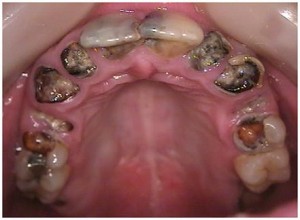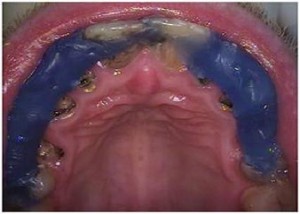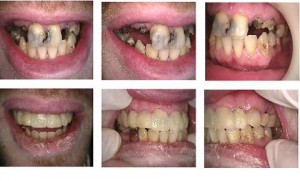I want to fix my smile.
February 1, 2010 7:48 pmA 32 year old Caucasian male presented with the chief complaint, “I want to fix my smile.” The patient complained of hot and cold sensitivity as well as swollen, bleeding gums after brushing.
Past Medical History: The patient is not on any medication and has no known allergies to food or medications. The patient also denied using any illicit drugs.
This patient had very limited funds to have his mouth fully rehabilitated. However, several treatment options were discussed with the patient which include:
# Extraction of the non restorable teeth
# Root canal therapy, cast gold post and core with final crown restoration of restorable teeth
# Composite restorations
# Crowns and bridges
However, the patient could not afford the treatment options provided. Based on this, a maxillary round-house provisional restoration was agreed upon. This was treatment planned; however the poor prognosis of some teeth was largely noted. The patient was solely concerned about his esthetic look, hence requested that only the maxillary arch be treated. Appropriate consent forms and treatment plans were signed prior to any rendered treatment.
Treatment Procedure
A maxillary local infiltration with Carbocaine was performed. Extraction of teeth #s 2, 5, 12 and 15 was also performed and hemostasis was achieved through the placement of sutures.
Peripheral wax was adapted over the maxillary arch area where the patient had worn-out teeth. An upper alginate impression was taken to serve as a matrix for the provisional restorations. Gross crown preparation reductions were done on all existing maxillary teeth with the exception of tooth #4 and #13 which were used to achieve occlusal stops to maintain the patient’s vertical dimension of occlusion.
With the use of the previously taken alginate impression matrix, Luxatemp was used as the temporary restorative material. This was injected into the alginate matrix and then re-seated on top of the prepared teeth. The temporary round-house restoration was taken out of the patient’s mouth and was trimmed and recontoured to proper shapes and sizes. It was then tried-in and final adjustments were made for the margins and contour. The occlusion was checked and then cemented temporarily into patient’s mouth. The patient was pleased with the work completed. From start to finish, the entire treatment procedure took approximately two hours.
Although, this was not the most beneficiary dental procedure that could have been rendered, considering the patient’s limited finances and his desire to look esthetically presentable, this was the best treatment that could have been provided at that moment. The patient was well informed about possible sensitivity following this treatment as well poor long term prognosis of some existing teeth.
Another option for treatment could have been extraction of all maxillary teeth and subsequent fabrication of an upper maxillary complete denture. The denture could have been implant supported to enhance stability and function of the denture. But this would have cost much more money that the patient could not afford.
Apart from rendering quality care to patients like this, a thorough dental and social history should be elicited from patients so that the etiology or possible risk factors causing such rampant nature of the disease be identified and addressed. This constitutes part of the treatment options. If this is not addressed, no matter the treatment rendered, it will surely fail. Good oral hygiene instructions should be given and frequent recall appointments given to such patients.
O.O., New York University College of Dentistry
Tags: fix smileCategorised in: Dental Student Experiences
This post was written by Dr. Jeffrey Dorfman


